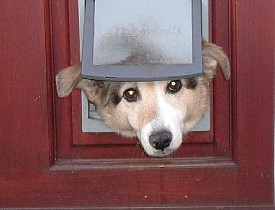Pets: Options for Doggie Doors
 All good dog owners want to take the best possible care of their little (or not so little) buddy. Having a doggie door allows your dog more options for exercise and "bathroom breaks." There are a few things to consider, though, when deciding to alter your home (and in one friend's case, apartment) for a doggie door. Moore Pet Supplies of LaCrosse, Wisconsin, offers tips to consider before you buy or install your doggie door.
All good dog owners want to take the best possible care of their little (or not so little) buddy. Having a doggie door allows your dog more options for exercise and "bathroom breaks." There are a few things to consider, though, when deciding to alter your home (and in one friend's case, apartment) for a doggie door. Moore Pet Supplies of LaCrosse, Wisconsin, offers tips to consider before you buy or install your doggie door.
Do You Need to Have an Electronic Door?
Electronic doggie doors operate on a connection between a magnet on a collar your dog wears, and the electronics installed in a panel on the door that controls access. "People believe they have to have an electronic door for security," says the Moore Pet Supply company representative. "In terms of security though, someone could just walk up to the door with a bag of fries and lure the dog out."
However, electronic doors are especially good for preventing nuisance animals, such as raccoons and skunks, from coming inside. "Since these animals are nocturnal, you especially want to keep them out while you are sleeping," he cautions. The quality of security can also depend on the materials used in the security panel, whether plastic or metal.
What is the Best Doggie Door Design for My Home?
The company rep advises, "The simplest design is generally the best design. Simplicity allows you peace of mind when you are not home. You want to be able to relax and not worry. I've heard of people losing their dogs to hawks, coyotes and even the cold due to a malfunctioning door." Each of his customers brings a different set of considerations to the table, depending on where they want to install the door and what breed of dog they own.
So, you want your doggie door to be functional for your situation. You need it to be secure and keep out critters you don't want in your home, and you will have to decide whether the pet door should be able to keep out the cold as well. The representative points out, "If the door goes into your house, you want to have a seal that feels like there is no door there at all."
Where Can You Install a Doggie Door?
The short answer is anywhere. Here's why:
- Doggie doors can be made for any door thickness.
- Doggie doors can be installed in windows and sliding glass doors. The glass is cut to the appropriate size and a panel is inserted with the door in the center or a corner. The door can even be placed where there would be a pane of glass in a French door.
- Wall models of doggie doors, made to the thickness of the wall, tend to be more secure and better insulators. Doors can be standard in-and out, "saloon" style, or dual-flap.
- Other places you can install a doggie door are screens, kennels, and garage doors.
Depending on where you want to install your doggie door, how specialized it is, and of course size, you will spend from $100 to upwards of $1000. Doors can be standard or customized and come with a variety of locking options.
What Size Doggie Door do You Need for Your Dog?
The company representative remarks, "Size and placement go hand-in hand." Allow a height of 1 ½ to 2 inches above the top of your dog's back and have the bottom low enough for your dog to be able to step through easily. "Older dogs or breeds that tend towards hip dysplasia sometimes can't lift their legs more than three inches," he cautions.
Last, remember that finding the right doggie door is "less a science and more taking into consideration what will work for you and your dog."
Find a pro to install your doggie door.
Cris Carl is a Networx writer.
Updated December 6, 2018.
Looking for a Pro? Call us (866) 441-6648

Average Costs
Related Experiences

Hardworking Handyman Brings Christmas To Southern California

We Needed A New Bathroom Vent Fan To Get Our House Renter-Ready



